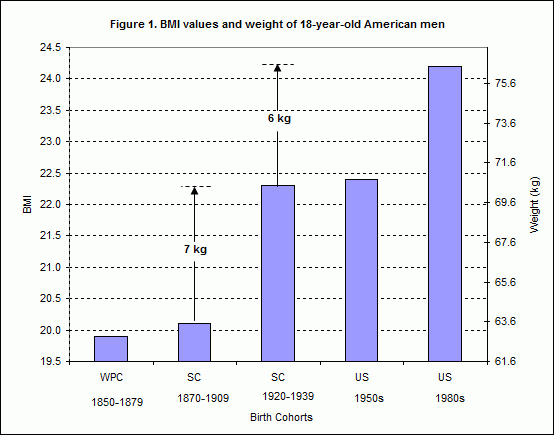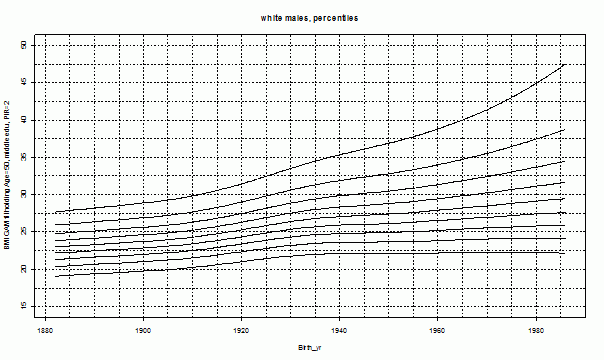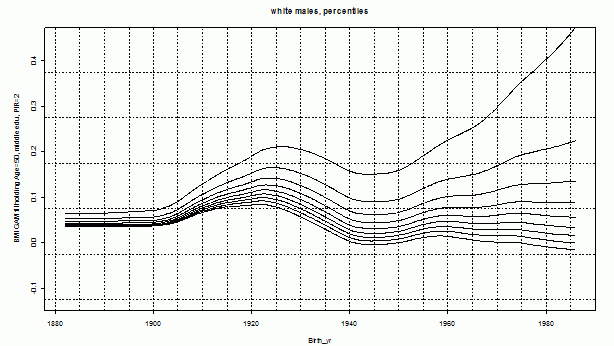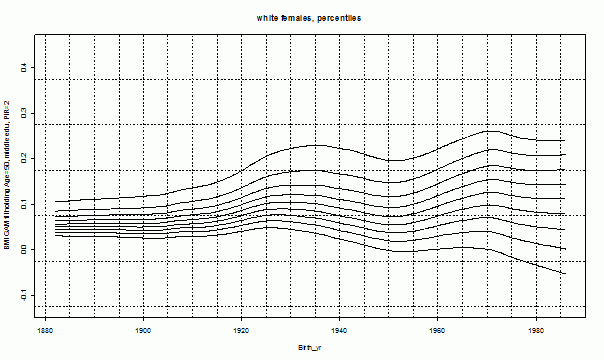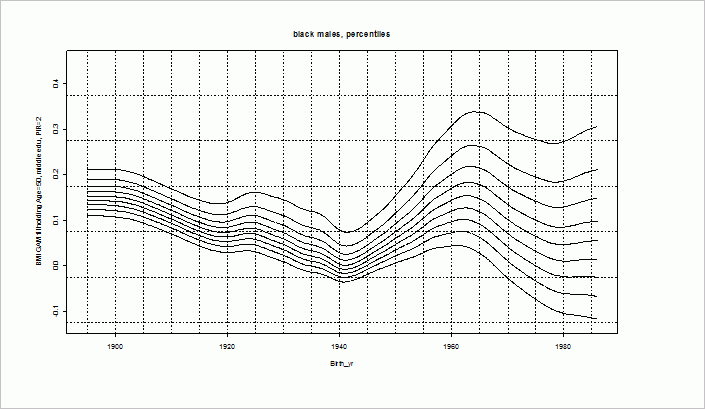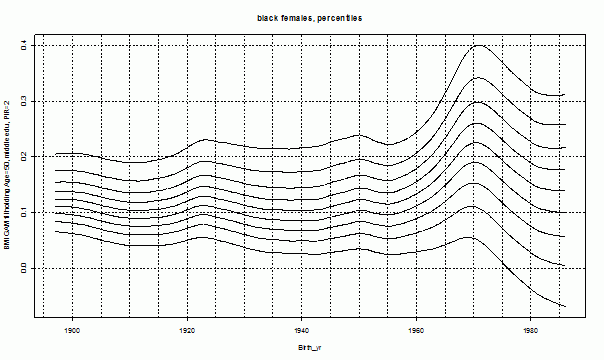It seems we are but helpless bystanders to the obesity pandemic sweeping the globe. More than a third of US adults, about 70 million persons, are obese. Yet before we can come up with appropriate measures to counter this disturbing trend, we need to know more about its development.
The official view propagated by the Centre for Disease Control is that in the US the epidemic appeared rather suddenly in the 1980s (Ogden et al., 2006). We believe this view is misleading. All the studies underpinning the official view refer to period effects – that is, they are based on data that are averaged across the population for particular years. They do not look at birth-cohort effects – that is, the evolution of weight among people of the same birth year.
We all know that weight changes over time, as do other variables, such as wages. Suppose you are earning $20 per hour today, but we do not know when you reached that wage. Similarly, when someone’s weight is measured we do not know when she reached that weight. Hence, the official estimates based on such measurements do not lead to convincing trends. This has prompted us to estimate the trends by birth cohorts in our recent research (Komlos and Brabec 2010). The advantage of this approach is that birth cohorts experienced similar social, economic, and technological changes that would have affected their weight. Similarly with wages – your wage today depends on what schools you attended from the very beginning.
Historical excursion
There is ample historical evidence that the roots of the obesity pandemic do reach much further back in time than is commonly asserted (Carson 2009, Cuff 1993, Komlos 1987). For the 19th century, we have samples from the West Point Military Academy revealing that by today’s standards BMI values were amazingly low: 19-year-old white cadets had an average BMI value of 20.5, i.e., about the 18th percentile of today’s standards.[1] About 90% of the cadets were below today’s median reference value. In addition, these data indicate that there was very little change in weights in the 19th century. However, another sample from The Citadel military academy in Charleston, SC indicates that a true surge in BMI values took place among those born after the First World War (Figure 1) (Coclanis and Komlos 1995). Note that 18-year-old men increased by some 13 kilograms (28.5 pounds) during the course of the 20th century but half of that increase took place among those born before World War II. Hence, these data indicate that a considerable increase in weight had already taken place by the time the first national survey was taken in 1959-1962 (Figure 1).
Figure 1. BMI values and weight of 18-year-old American men
Note: Data pertains to whites. WPC= West Point Cadets; SC = students attending The Citadel Military Academy in Charleston, SC; US = national sample. The weights pertain to a man who is 70 inches (177.8 cm) tall.
Results of decile estimates
Against this historical backdrop, we turn to the national samples collected between 1959 and 2006 by the National Center for Health Statistics. In contrast to the historical evidence, these provide representative samples of the US population. Using these data we estimate BMI values (kg/m2)by deciles of adults in four categories: white male, white female, black male, and black female. For modelling the BMI distribution and its dependence on several covariates, we use the approach based on the generalised additive model for location, scale, and shape (GAMLSS), developed by Rigby and Stasinopoulos (2007).
We find that a persistent increase in BMI values was already underway among the birth cohorts of the turn of the 20th century in all four groups (Figure 2). We present the graph for white men only but the estimates are quite similar for the other three groups in that the shapes traced out by the BMI deciles can be characterised as a half-fan. (Note that inasmuch as the distribution is divided into 10 deciles, there are 9 lines in Figure 2 that depict the borders of the deciles – i.e., the lines correspond to the 10th, 20th, …, 90th percentiles.)
The upper deciles rotate upwards as the ridges of a fan while the lower ones remained essentially unchanged. The highest deciles increased by some 18 to 22 units during the century under consideration while the lowest ones increased by merely 1 to 3 units. This implies that the distribution became extremely skewed to the right. In other words the lower part of the distributionhardly increased at all but the upper part of the distribution increased more and more rapidly over time.
Translated into weight, these increases in BMI values imply that, for instance, in the 10th percentile a 64inch (162.6 cm) tall women would have increased in weight during the 20th century by just 12 pounds (5 kg) whereas in the 90th percentile her weight would have increased by an amazing 128 pounds (58 kg) or some 70%. The spread between the lowest and highest deciles about tripled: in three of the groups the gap rose from approximately 8 to 25 BMI units while among black women the spread increased from 10 to 30 BMI units in the course of the century. Hence, among black women the difference in weight between the 10th and the 90th percentile increased from 58 pounds (26 kg) to 174 pounds (79 kg).
Figure 2. Trend of BMI decile curves of US-born white men by birth cohorts
Rate of change of decile curves
The rate of change of BMI decile curves (obtained as derivative of the decile curves with respect to birth year)varied substantially over time in all four groups under study (Figures 3-6). A key finding is the rapid acceleration in BMI values among the cohorts born right after World War I among white men and women. This was accompanied by a marked divergence between the lower and upper deciles leading to extreme skewness of the BMI distribution. The acceleration was followed by a decelerating phase during the Great Depression. There was a second phase of rapid upswing in BMI deciles after World War II. This time all four ethnic/gender groups participated in the upswing.
Figure 3. Rate of change of BMI decile curves of white men by birth cohorts in Figure 2
Figure 4. Rate of change of BMI decile curves of white females by birth cohorts
Figure 5. Rate of change of BMI decile curves of black men by birth cohorts
Figure 6. Rate of change of BMI decile curves of black females by birth cohorts
Conclusion
The lifestyle changes of the 20th century affected the four groups under study somewhat differently. Identifying the deep causes of the long-run trends is outside of the scope of this study, but the “creeping” nature of the epidemic, as well as its persistence, does suggest that its roots are embedded deep in the social fabric and are nourished by a network of disparate slowly changing sources as the 20th-century US population responded to a vast array of irresistible and impersonal socio-economic and technological forces.
The most obviously persistent among these were:
- the major labour-saving technological changes of the 20th century,
- the industrial processing of food and with it the spread of fast-food eateries (To illustrate the spread of fast food culture, consider that White Castle, the first drive-in restaurant, was founded in 1921. McDonald started operation in the late 1940s, Kentucky Fried Chicken in 1952, Burger King in 1954, Pizza Hut in 1958, Taco Bell in 1962, and Subway in 1962.),
- the associated culture of consumption,
- the rise of an automobile-based way of life,
- the introduction of radio and television broadcasting,
- the increasing participation of women in the work force, and
- the IT revolution.
These elements – taken together – virtually defined American society in the 20th century (Chou et al. 2008, Cutler et al. 2003, Hamermesh 2010, Lakdawalla and Philipson 2009, Offer 2006, Philipson and Posner 2003, Popkin, 2004).
Noteworthy in this regard is that the timing of the first accelerating phase after World War I among whites coincided with the spread of radios and automobiles, while the timing of the second accelerating phase of the 1950s cohorts among both blacks and whites coincided perfectly with the spread of television viewing and the spread of fast food consumption.
The fact that the obesity epidemic started earlier than hitherto thought also implies that the current weight and BMI standards published by the Centre for Disease Control are inaccurate, i.e., not ideal for gauging the true extent of the obesity epidemic especially among children and youth. Reference charts are supposed to reflect what is “normal” within the society. In this case, however, they do not do so, insofar as they incorporate BMI values obtained at a time when the transition to post-industrial weights was already under way, i.e., at a time when obesity was already more widespread than in historical times. That was an arbitrary choice. The current standards are thereby misleading as they suggest that the weights obtained in the midst of the obesity pandemic were actually normal ones. As a consequence, many overweight and obese children and youth are misled into believing that their weight is normal – when it is not. The US should strive to adopt standards such as those in the Netherlands, where policymakers are less content to stand by and watch an obesity epidemic spread unabated.
References
Carson, SA (2009), “Racial differences in body mass indices of men imprisoned in 19th century Texas”, Economics and Human Biology, 7:121-127.
Chou, SY, I Rashad, and M Grossman (2008), “Fast-Food Restaurant Advertising on Television and Its Influence on Childhood Obesity”, Journal of Law and Economics, 51:599-618.
Coclanis, P and J Komlos (1995), “Nutrition and Economic Development in Post-Reconstruction South Carolina: an Anthropometric Approach”, Social Science History, 19:91-116.
Cuff, T (1993), “The Body Mass Index Values of Mid-Nineteenth-Century West Point Cadets: A Theoretical Application of Waaler's Curves to a Historical Population”, Historical Methods 26:171-82.
Cutler, DM, EL Glaeser, and JM Shapiro (2003), “Why Have Americans Become More Obese?”, Journal of Economic Perspectives 17:93-118.
Hamermesh, D (2010), “Incentives, time use and BMI: The roles of eating, grazing and goods”, Economics and Human Biology, 8:2-15.
Komlos, J (1987), “The Height and Weight of West Point Cadets: Dietary Change in Antebellum America”, Journal of Economic History, 47:897-927.
Komlos, J and M Brabec (2010), “The Trend of BMI Values by Deciles of US Adults, birth cohorts 1882-1986” NBER Working Paper 16252.
Lakdawalla, D and T Philipson (2009), “The growth of obesity and technological change”, Economics and Human Biology, 7:283-293.
Offer, A (2006), The Challenge of Affluence: Self-control and Well-being in the USA and Britain since 1950, Oxford University Press.
Ogden, CL, MD Carroll, LR Curtin, MA McDowell, CJ Tabak, and KM Flegal (2006), “Prevalence of overweight and obesity in the US, 1999-2004”, Journal of the American Medical Association, 295:1549-1555.
Philipson, T and R Posner (2003), “The Long Run Growth of Obesity as a Function of Technological Change”, Perspectives in Biology and Medicine, 46:87-108.
Popkin, BM (2004), “The Nutrition Transition: Worldwide Obesity Dynamics and Their Determinants”, International Journal of Obesity,28:S2-S9.
Rigby, RA, DM Stasinopoulos (2007), “Generalized additive models for location, scale and shape GAMLSS)”, Royal Journal of Statistical Software, 23(7):1-46.
[1] Note that, in contrast, today’s BMI reference value for 20-year-old females is 21.7.
